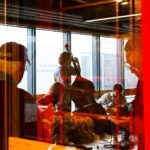
The unique and reciprocal relationship between artists and the printers and publishers who bring their work to life has led to some of the most iconic works and series of the past century. An invaluable avenue of creation and expression for artists, editions, portfolios, and works on paper also offer collectors an opportunity to diversify their collections, as the entry points for these works—particularly of blue-chip artists—are more accessible.
Marking the Premier Prints and Multiples: Summer Edition sale, now live on Artnet Auctions for bidding through April 3, 2025, we reached out to four leading printers and publishers to hear in their own words what goes into working with an artist on a new project.
Jonas Wood, Kitchen Interior (2022)

Jonas Wood, Kitchen Interior (2022). Est. $20,000–$30,000.
“My previous publishing company, Aliso Editions, co-produced ‘Kitchen Interior’ with Jonas’s in-house publishing venture, WKS Editions. A 112-color silkscreen produced over a period of 20 months, the ambitious print involved periodic meetings at the artist’s studio with the master printer Kevin Giffen. After approximately 10 colors were printed, a ‘Stage Proof’ was pulled and set aside, with a final number of these prints showing the progression of the print’s development and changes. The scale of the logistics involved in such a print really highlights the skill of the printers, and how ambitious an artist can be with printmaking processes.
I first met Jonas while working as a printmaker at Cirrus Editions from 2012 to 2020, and I was always impressed by the dedication of both Jonas and Jean Milant to the continued future of printmaking in Los Angeles.
Moving on from Aliso Editions, I formed a new publishing company with my wife in 2023, named Ollin Editions. Despite losing our home and entire archive of prints and artworks in the Eaton Fire, we are aiming to rebuild in Altadena, and to continue collaborating with artists and master printers in Los Angeles and New York.” — Emmett Walsh, Co-Director of Ollin Editions
Lynda Benglis, Rajesh in Rajasthan (2012–2016)
Lynda Benglis, Rajesh in Rajasthan (2012–2016). Est. $30,000–$50,000.
“When I started my company in 2012, I was dealing glass, ceramics, and decorative art, as well as some photography—while my background is actually architecture. I was focused on everything besides drawing, painting, and sculpture, and was thinking about the overlap between fine art and craft. I was very interested in working with older artists for no other reason than the art world was changing, and I wanted to be around them to learn more about their careers starting in the 1950s, ’60s, and ’70s. I had been spending time with Robert Frank and June Leaf and felt every minute with them was a gift. It was very profound for me, hearing Robert tell his own stories about his work.
Around that time, I showed John Cheim a list of artists I wanted to approach about making editions in ceramic, glass, or textiles, and he immediately thought of an artwork Lynda just made, Rajesh in Rajasthan, and arranged our meeting in person at the gallery. She agreed that a tapestry based on the painting, made to scale, would be beautiful. It then took me three years to find weavers who could make the rug in such detail. I still work with this Nepalese designer today and actually met him for the first time in October 2024 in Kathmandu. During my time with him and his family, we traveled to Nargakot, a mountain with views of Mt. Everest and the other Himalayas, for a 4 a.m. hike. Nepal has open borders to India, which is where Lynda made the painting, Rajesh in Rajasthan.
After Lynda and I met in New York, I had samples of the tapestry made for her to confirm colors. Finally, we agreed on the over 20 colors we found in the painting, and I had the tapestries made in full. She has her two APs in her studios in New York and New Mexico. The tapestry is about 8 by 8 feet, with the look and feel of a highly detailed, traditional Oriental rug. This is the only artist’s work I have produced, however, and mostly all I design and deal now are beautiful Nepalese rugs in animal fibers such as mohair, pashmina, cashmere, silk, and wool, and plant fibers native to the Himalayas such as hemp, linen, giant nettle, and sunpat. The unique Nepalese knot and materials available at markets there make for the most exceptional quality textiles and rugs you can find today.” —Ashley Klein, Owner, Booth Art, Inc.
John Baldessari, Money (with Space Between) (1994)
John Baldessari, Money (with Space Between) (1994). Est. $12,000–$18,000.
“In 1991, John Baldessari began his first collaboration with Gemini G.E.L., the renowned print publisher and workshop in Los Angeles. Already an influential figure in conceptual art, Baldessari brought his distinct visual language, anchored in appropriation, fragmentation, and the semiotics of imagery, to the print medium. His initial series, ‘A French Horn Player, A Square Blue Moon, and Other Subjects,’ resulted in eight large-scale lithographs with screen printing, marking a new chapter in his exploration of the relationship between image and meaning, particularly within the context of mass media and cinematic tropes.
That same year, on June 28, 1991, Baldessari was interviewed by National Gallery curator Mark Rosenthal for the publication of Artists at Gemini G.E.L.—Celebrating the 25th Year I (1993). Their conversation offers key insights into Baldessari’s motivations and strategies, particularly regarding his 1994 print Money (with Space Between). In the interview, Baldessari describes his use of money imagery as part of a broader interest in gestures and cultural symbols. ‘The exchange of money is archetypal and shows up a lot in movie imagery,’ he explains. ‘Again, like violence, it’s certainly part of the world.’
In Money (with Space in Between), Baldessari physically splits the image, the two anonymous figures handing money to each other, emphasizing a central conceptual tension between the transactional nature of relationships and meaning. ‘It’s the idea of the torn dollar bill,’ he explains to Rosenthal, ‘with one person having one half and another the other half. When the dollar is complete, the relationship is somehow complete. I am exploring the transaction, which involves two parts becoming whole.’
During this period, Baldessari’s work with Gemini exemplified his interest in using formal strategies of cropping, doubling, juxtaposition to question how meaning is constructed and shared in a culture saturated with images.” — Natalie Marsh, Sales Team, Gemini G.E.L.
Alex Katz, Red Dogwood 1 (from “Flowers”) (2021)
Alex Katz, Red Dogwood 1 (from “Flowers”) (2021). Est. $10,000–$15,000.
“The decades-long relationship between Alex Katz and Lococo Fine Art is a model of how trust, shared vision, and personal rapport can fuel meaningful collaboration in print publishing. At its heart is a deep friendship between Katz and Robert Lococo, rooted in respect for the artist’s evolving practice and sustained through an unwavering commitment to creative integrity.
Lococo Fine Art does not approach publishing as a transactional exchange. Instead, its method is grounded in conversation and creative alignment. Katz’s studio has become a familiar setting for Robert and his team, where they regularly sit with the artist to review recent paintings and select images that lend themselves powerfully to print or sculptural edition. This ongoing dialogue often focuses on current studio work but occasionally revisits older paintings that could not previously be realized because of technical or financial constraints. When new tools or formats become available, the Lococo team looks for opportunities to help bring those ideas to life.
The ‘Flowers’ portfolio, produced in 2020, is the result of one such process. Katz and Lococo selected a suite of vibrant floral paintings to translate into large-scale archival pigment prints. Red Dogwood 1 is a highlight from the group. It distills the movement and delicacy of clustered blossoms into a composition of bold color and lyrical rhythm. The print’s size, 35-by-47 inches, is characteristic of Lococo’s ambition to think big. ‘We make the biggest and most important prints in the world,’ Robert Lococo often says a philosophy is evident in both scale and execution.
Lococo Fine Art not only publishes the work but also finances and distributes each edition globally, allowing the artist full creative focus. ‘Pay fast, make friends’ is another of Robert’s guiding principles. For Katz, this means more than just efficiency. It creates a foundation of trust that allows for deep creative investment across every stage of the project, from proofing to paper selection to final sign-off.
In Red Dogwood 1, Katz captures the quiet confidence and visual punch that have defined his career. His graphic, reductive style—marked by crisp edges, flattened planes, and the elimination of unnecessary detail lends itself naturally to printmaking. The medium allows his compositions to reach their full expressive potential, emphasizing clarity of form and immediacy of color. In this work, the blossoms appear to float against a vibrant yellow ground, giving the impression of something simultaneously timeless and freshly observed. Through Lococo’s collaborative lens, the work becomes part of a lasting legacy, one that reflects decades of friendship, shared ambition, and a love for creating monumental prints that endure.” —Matt Mercer, Arist Liaison, Sales, and Marketing Manager, Lococo Fine Art
Premier Prints and Multiples: Summer Edition is live for bidding now through July 31, 2025.




